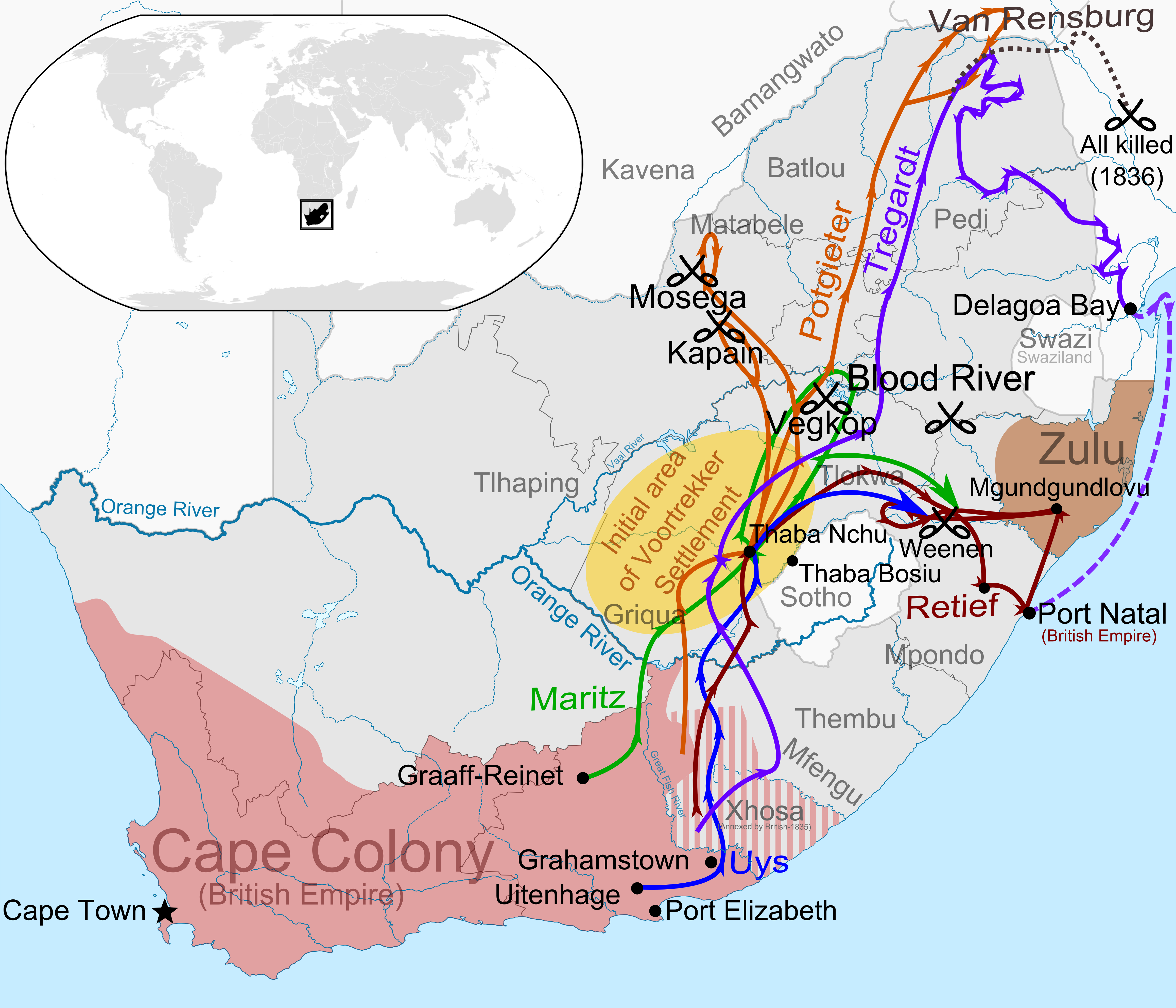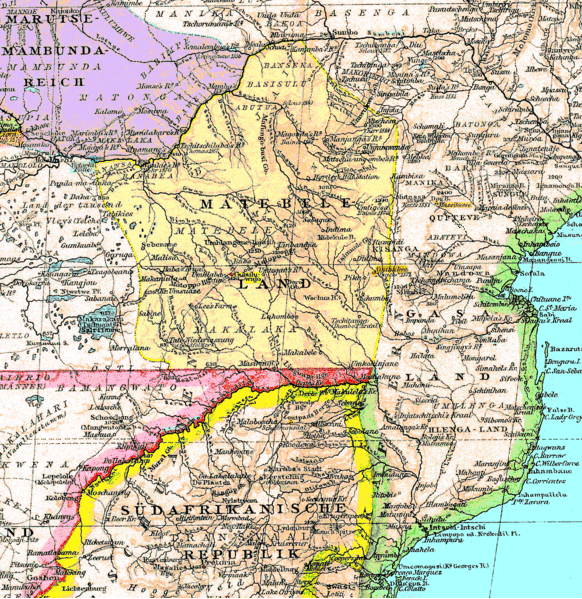|
Siege Of Mafeking
The siege of Mafeking was a 217-day siege battle for the town of Mafeking (now called Mahikeng) in South Africa during the Second Boer War from October 1899 to May 1900. The siege received considerable attention as Lord Edward Cecil, the son of the British prime minister, was in the besieged town, as also was Lady Sarah Wilson, a daughter of the Duke of Marlborough and aunt of Winston Churchill. The siege turned the British commander, Colonel Robert Baden-Powell, into a national hero. The Relief of Mafeking (the lifting of the siege), while of little military significance, was a morale boost for the struggling British. Prelude Shortly before the outbreak of the Second Boer War in 1899, Lord Wolseley, Commander-in-Chief of the British Army, who had failed to persuade the British government to send troops to the region, instead sent Colonel Robert Baden-Powell, accompanied by a handful of officers, to the Cape Colony to raise two regiments of mounted rifles from Rhodesia. ... [...More Info...] [...Related Items...] OR: [Wikipedia] [Google] [Baidu] |
Second Boer War
The Second Boer War (, , 11 October 189931 May 1902), also known as the Boer War, Transvaal War, Anglo–Boer War, or South African War, was a conflict fought between the British Empire and the two Boer republics (the South African Republic and Orange Free State) over Britain's influence in Southern Africa. The Witwatersrand Gold Rush caused a large influx of "Uitlander, foreigners" (''Uitlanders'') to the South African Republic (SAR), mostly British from the Cape Colony. As they, for fear of a hostile takeover of the SAR, were permitted to vote only after 14 years of residence, they protested to the British authorities in the Cape. Negotiations failed at the botched Bloemfontein Conference in June 1899. The conflict broke out in October after the British government decided to send 10,000 troops to South Africa. With a delay, this provoked a Boer and British ultimatum, and subsequent Boer Irregular military, irregulars and militia attacks on British colonial settlements in Natal ... [...More Info...] [...Related Items...] OR: [Wikipedia] [Google] [Baidu] |
Orange Free State
The Orange Free State ( ; ) was an independent Boer-ruled sovereign republic under British suzerainty in Southern Africa during the second half of the 19th century, which ceased to exist after it was defeated and surrendered to the British Empire at the end of the Second Boer War in 1902. It is one of the three historical precursors to the present-day Free State (province), Free State province. Extending between the Orange River, Orange and Vaal River, Vaal rivers, its borders were determined by the United Kingdom of Great Britain and Ireland in 1848 when the region was proclaimed as the Orange River Sovereignty, with a British Resident based in Bloemfontein. Bloemfontein and the southern parts of the Sovereignty had previously been settled by Griqua people, Griqua and by ''Trekboere'' from the Cape Colony. The ''Voortrekkers, Voortrekker'' Natalia Republic, Republic of Natalia, founded in 1837, administered the northern part of the territory through a ''landdrost'' based at ... [...More Info...] [...Related Items...] OR: [Wikipedia] [Google] [Baidu] |
Railway
Rail transport (also known as train transport) is a means of transport using wheeled vehicles running in railway track, tracks, which usually consist of two parallel steel railway track, rails. Rail transport is one of the two primary means of land transport, next to road transport. It is used for about 8% of passenger and rail freight transport, freight transport globally, thanks to its Energy efficiency in transport, energy efficiency and potentially high-speed rail, high speed.Rolling stock on rails generally encounters lower friction, frictional resistance than rubber-tyred road vehicles, allowing rail cars to be coupled into longer trains. Power is usually provided by Diesel locomotive, diesel or Electric locomotive, electric locomotives. While railway transport is capital intensity, capital-intensive and less flexible than road transport, it can carry heavy loads of passengers and cargo with greater energy efficiency and safety. Precursors of railways driven by human or an ... [...More Info...] [...Related Items...] OR: [Wikipedia] [Google] [Baidu] |
Piet Cronje
Piet may refer to: People * Piet (given name), a list of people with the name * Piet (surname), a list of people with the name Schools * Purushottam Institute of Engineering and Technology, Rourkela, Orissa, India * Priydarshini Institute of Engineering and Technology, Nagpur, Maharashtra, India * Pakistan Institute of Engineering and Technology, Multan, Punjab, Pakistan Other uses * Piet (programming language) An esoteric programming language (sometimes shortened to esolang) is a programming language designed to test the boundaries of computer programming language design, as a proof of concept, as software art, as a hacking interface to another language ... * Piet (horse), American thoroughbred racehorse {{disambig ... [...More Info...] [...Related Items...] OR: [Wikipedia] [Google] [Baidu] |
Paul Kruger
Stephanus Johannes Paulus Kruger (; 10 October 1825 – 14 July 1904), better known as Paul Kruger, was a South African politician. He was one of the dominant political and military figures in 19th-century South Africa, and State President of the South African Republic (or Transvaal) from 1883 to 1900. Nicknamed , he came to international prominence as the face of the Boer cause—that of the Transvaal and its neighbour the Orange Free State—against Britain during the Second Boer War of 1899–1902. He has been called a personification of Afrikanerdom and admirers venerate him as a tragic folk hero. Born near the eastern edge of the Cape Colony, Kruger took part in the Great Trek as a child during the late 1830s. He had almost no education apart from the Bible. A protégé of the Voortrekker leader Andries Pretorius, he witnessed the signing of the Sand River Convention with Britain in 1852 and over the next decade played a prominent role in the forging of the South ... [...More Info...] [...Related Items...] OR: [Wikipedia] [Google] [Baidu] |
Trench Warfare
Trench warfare is a type of land warfare using occupied lines largely comprising Trench#Military engineering, military trenches, in which combatants are well-protected from the enemy's small arms fire and are substantially sheltered from artillery. It became archetypically associated with World War I (1914–1918), when the Race to the Sea rapidly expanded trench use on the Western Front (World War I), Western Front starting in September 1914.. Trench warfare proliferated when a Weapons of World War I, revolution in firepower was not matched by similar advances in mobility (military), mobility, resulting in a grueling form of warfare in which the defender held the advantage. On the Western Front in 1914–1918, both sides constructed elaborate trench, underground, and dugout (shelter), dugout systems opposing each other along a front (military), front, protected from assault by barbed wire. The area between opposing trench lines (known as "no man's land") was fully exposed ... [...More Info...] [...Related Items...] OR: [Wikipedia] [Google] [Baidu] |
Boer Trenches At The Siege Of Mafeking - The Graphic - 1900
Boers ( ; ; ) are the descendants of the proto Afrikaans-speaking Free Burghers in the Dutch Cape Colony, Free Burghers of the eastern Cape Colony, Cape frontier in Southern Africa during the 17th, 18th, and 19th centuries. From 1652 to 1795, the Dutch East India Company controlled the Dutch Cape Colony, which the United Kingdom incorporated into the British Empire in 1806. The name of the group is derived from Trekboer then later "boer", which means "farmer" in Dutch language, Dutch and Afrikaans. In addition, the term also applied to those who left the British Cape Colony, Cape Colony during the 19th century to colonise the Orange Free State, and the South African Republic, Transvaal (together known as the Boer Republics), and to a lesser extent Natalia Republic, Natal. They emigrated from the Cape to live beyond the reach of the British colonial administration, with their reasons for doing so primarily being the new Anglophone common law system being introduced into the C ... [...More Info...] [...Related Items...] OR: [Wikipedia] [Google] [Baidu] |
Scouting
Scouting or the Scout Movement is a youth social movement, movement which became popularly established in the first decade of the twentieth century. It follows the Scout method of informal education with an emphasis on practical outdoor activities, including camping, woodcraft, aquatics, hiking, Backpacking (wilderness), backpacking and sports. A widely recognized movement characteristic is the Scout uniform, by intent Social hierarchies, hiding all differences of social standing and encouraging Social equality, equality, with neckerchief (known as a scarf in some countries) and (originally) a campaign hat or comparable Headgear, headwear. Distinctive insignia include the World Scout Emblem, fleur-de-lis as well as Scout badge, merit badges or patches. In some countries, Girl Guides organizations, using a trefoil insignia, exist for girls to carry-out scout training. Other programs for children who are too young to be Scouts and take the Scout Promise, such as Wolf Cubs or Cub ... [...More Info...] [...Related Items...] OR: [Wikipedia] [Google] [Baidu] |
Mafeking Cadet Corps
The Mafeking Cadet Corps was a group of boy cadets formed by Lord Edward Cecil shortly before the 217 day Siege of Mafeking in South Africa during the Second Boer War in 1899–1900. Cecil, the son of the British prime minister, was the staff officer and second-in-command of the garrison. The cadets consisted of volunteer boys below fighting age and were used to support the troops, carry messages, and help in the hospital. This freed up men for military duties, and kept the boys occupied. The cadets were given khaki uniforms, a wide-brimmed hat which they wore with one side turned up and a Glengarry cap. The towns people often commented on their smartness. 13-year-old Sergeant-Major Warner Goodyear was their leader. The Mafeking Cadets are claimed to be one of the inspirations for the Boy Scouts. Cadet duties One of the cadets' duties was to carry messages around the town and to outlying forts, sometimes as much as a mile away across open ground. At first they used donkeys, ... [...More Info...] [...Related Items...] OR: [Wikipedia] [Google] [Baidu] |
Jameson Raid
The Jameson Raid (Afrikaans: ''Jameson-inval'', , 29 December 1895 – 2 January 1896) was a botched raid against the South African Republic (commonly known as the Transvaal) carried out by British colonial administrator Leander Starr Jameson, under the employment of Cecil Rhodes. It involved 500 British South Africa Company police and was launched from Rhodesia over the New Year weekend of 1895–96. Paul Kruger, for whom Rhodes had great personal hatred, was president of the South African Republic at the time. The raid was intended to trigger an uprising by the primarily British expatriate workers (known as Uitlanders) in the Transvaal, but it failed. The workers were referred to as the Johannesburg Conspirators. They were expected to recruit an army and prepare for an insurrection; however, the raid was ineffective, and no uprising took place. The results included embarrassment of the British government; the replacement of Cecil Rhodes as prime minister of the Cape Colon ... [...More Info...] [...Related Items...] OR: [Wikipedia] [Google] [Baidu] |






